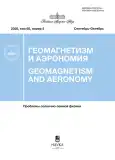Pre- and post-midnight equatorial plasma bubbles
- Авторлар: Sidorova L.N.1
-
Мекемелер:
- Pushkov Institute of Terrestrial Magnetism, Ionosphere and Radiowave Propagation
- Шығарылым: Том 65, № 5 (2025)
- Беттер: 677-690
- Бөлім: Articles
- URL: https://journal-vniispk.ru/0016-7940/article/view/352726
- DOI: https://doi.org/10.7868/S3034502225050116
- ID: 352726
Дәйексөз келтіру
Аннотация
The development of equatorial plasma bubbles was considered in the latitude-altitude and local time dynamics. The obtained pattern was used to study the particular features of the pre- and post-midnight equatorial plasma bubbles. For this purpose, а detailed comparative analysis of the histograms of latitudinal and local-time variations in the occurrence probability of bubbles at altitudes was carried out. Data from the AE-E (~350−475 km), ROCSAT-1 (~600 km) and ISS-b (~972−1220 km) satellites which different orbital altitudes were included. Observations were carried out during the years of the increasing and maximum solar activity. It was found that the probability of occurrence of the equatorial plasma bubbles in the equatorial and low-latitude regions at the altitudes of ~350−1200 km is maximum before the midnight. On the other hand, the maximum occurrence probability of bubbles in the mid-latitude region at the altitudes of ~600−1200 km was recorded after midnight. It was concluded that the dominance of post-midnight equatorial plasma bubbles in the mid-latitude region is associated with the dynamics of their rise and increase in geometric size.
Авторлар туралы
L. Sidorova
Pushkov Institute of Terrestrial Magnetism, Ionosphere and Radiowave Propagation
Хат алмасуға жауапты Автор.
Email: lsid@izmiran.ru
Moscow, Troitsk, Russia
Әдебиет тізімі
- Сидорова Л.Н., Филиппов С.В. Долготная статистика плазменных “пузырей”, видимых на высотах верхней ионосферы в концентрации Не+ // Геомагнетизм и аэрономия. Т. 53. № 1. С. 64−77. 2013. https://doi.org/10.7868/S0016794012060107
- Сидорова Л.Н., Филиппов С.В. Экваториальные плазменные “пузыри”: Влияние термосферных ветров, модулированных приливной волной DE3 // Геомагнетизм и аэрономия. Т. 58. № 2. С. 225–233. 2018. https://doi.org/10.7868/S0016794018020086
- Сидорова Л.Н. Экваториальные плазменные пузыри: Зависимость вероятности наблюдения от местного времени // Геомагнетизм и аэрономия. Т. 60. № 5. С. 557–565. 2020. https://doi.org/10.31857/S0016794020050144
- Сидорова Л.Н. Экваториальные плазменные пузыри: Изменчивость широтного распределения с высотой // Геомагнетизм и аэрономия. Т. 61. № 4. C. 445–456. 2021. https://doi.org/10.31857/S0016794021040167
- Abdu M.A., de Medeiros R.T., Sobral J.H.A., Bittencourt J.A. Spread F plasma bubble vertical rise velocities determined from spaced ionosonde observations // J. Geophys. Res. – Space. V. 88. № 11. P. 9197–9204. 1983. https://doi.org/10.1029/JA088iA11p09197
- Bowman G.G. A relationship between polar magnetic substorms, ionospheric height rises and the occurrence of spread F // J. Atmos. Terr. Phys. V. 40. № 6. P. 713–722. 1978. https://doi.org/10.1016/0021-9169(78)90129-0
- Burke W.J. Plasma bubbles near the dawn terminator in the topside ionosphere // Planet. Space Sci. V. 27. № 9. P. 1187−1193. 1979. https://doi.org/10.1016/0032-0633(79)90138-7
- Burke W.J., Donatelli D.E., Sagalyn R.C., Kelley M.C. Low density regions observed at high altitudes and their connection with equatorial spread F // Planet. Space. Sci. V. 27. № 5. P. 593−601. 1979. https://doi.org/10.1016/0032-0633(79)90157-0
- Comberiate J., Paxton L.J. Coordinated UV imaging of equatorial plasma bubbles using TIMED/GUVI and DMSP/SSUSI // Space Weather. V. 8. № 10. ID S10002. 2010. https://doi.org/10.1029/2009SW000546
- Dao E., Kelley M.C., Roddy P., Retterer J., de La Beaujardière O., Su Y.-J. Longitudinal and seasonal dependence of nighttime equatorial plasma density irregularities during solar minimum detected on the C/NOFS satellite // Geophys. Res. Lett. V. 38. № 10. ID L10104. 2011. https://doi.org/10.1029/2011GL047046
- Fejer B.G., Scherliess L., de Paula E.R. Effects of the vertical plasma drift velocity on the generation and evolution of equatorial spread F // J. Geophys. Res. – Space. V. 104. № 9. P. 19859–19869. 1999. https://doi.org/10.1029/1999JA900271
- Hanson W.B., Coley W.R., Heelis R.A., Urquhart A.L. Fast equatorial bubbles // J. Geophys. Res. – Space. V. 102. № 2. P. 2039−2045. 1997. https://doi.org/10.1029/96JA03376
- Huba J.D., Joyce G., Krall J. Three-dimensional equatorial spread F modeling // Geophys. Res. Lett. V. 35. № 10. ID L10102. 2008. https://doi.org/10.1029/2008GL033509
- Kil H., Heelis R.A. Global distribution of density irregularities in the equatorial ionosphere // J. Geophys. Res. – Space. V. 103. № 1. P. 407−417. 1998. https://doi.org/10.1029/97JA02698
- Li G., Ning B., Liu L., Wan W., Liu J.Y. Effect of magnetic activity on plasma bubbles over equatorial and low-latitude regions in East Asia // Ann. Geophys. V. 27. № 1. P. 303–312. 2009. https://doi.org/10.5194/angeo-27-303-2009
- McClure J.P., Hanson W.B., Hoffman J.F. Plasma bubbles and irregularities in the equatorial ionosphere // J. Geophys. Res. V. 82. № 19. P. 2650−2656. 1977. https://doi.org/10.1029/JA082i019p02650
- Ott E. Theory of Rayleigh−Taylor bubbles in the equatorial ionosphere // J. Geophys. Res. – Space. V. 83. № 5. P. 2066−2070. 1978. https://doi.org/10.1029/JA083iA05p02066
- Ossakov S.L., Chaturvedi P.K. Morphological studies of rising equatorial spread F bubbles // J. Geophys. Res. – Space. V. 83. № 5. P. 2085−2090. 1978. https://doi.org/10.1029/JA083iA05p02085
- Palmroth M., Laakso H., Fejer B.G., Pfaff R.F. Jr. DE 2 observations of morningside and eveningside plasma density depletions in the equatorial ionosphere // J. Geophys. Res. – Space. V. 105. № 8. P. 18429–18442. 2000. https://doi.org/10.1029/1999JA005090
- RRL. Summary plots of ionospheric parameters obtained from Ionosphere Sounding Satellite-b. Tokyo: Radio Research Laboratories. Ministry of Posts and Telecommunications. V. 1−3. 1983.
- RRL. Summary plots of ionospheric parameters obtained from Ionosphere Sounding Satellite-b. Tokyo: Radio Research Laboratories. Ministry of Posts and Telecommunications. Special Report. V. 4. 1985.
- Sidorova L.N., Filippov S.V. Topside ionosphere He+ density depletions: seasonal/longitudinal occurrence probability // J. Atmos. Sol.-Terr. Phy. V. 86. P. 83–91. 2012. https://doi.org/10.1016/j.jastp.2012.06.013
- Sidorova L.N., Filippov S.V. Plasma bubbles in the topside ionosphere: estimations of the survival possibilities // J. Atmos. Sol.-Terr. Phy. V. 119. P. 35–41. 2014. 10.1016/j.jastp.2014.06.013' target='_blank'>https://doi: 10.1016/j.jastp.2014.06.013
- Sidorova L.N., Filippov S.V. Four-peak longitudinal distribution of the equatorial plasma bubbles observed in the topside ionosphere: Possible troposphere tide influence // Adv. Space Res. V. 61. № 6. P. 1412–1424. 2018. https://doi.org/10.1016/j.asr.2017.12.035
- Singh S., Bamgboye D.K., McClure J.P., Johnson F.S. Morphology of equatorial plasma bubbles // J. Geophys. Res. – Space. V. 102. № 9. P. 20019−20029. 1997. https://doi.org/10.1029/97JA01724
- Smith J., Heelis R.A. Equatorial plasma bubbles: Variations of occurrence and spatial scale in local time, longitude, season, and solar activity // J. Geophys. Res. – Space. V. 122. № 5. P. 5743−5755. 2017. https://doi: 10.1002/2017JA024128
- Stolle С., Lühr H., Rother M., Balasis G. Magnetic signatures of equatorial spread F as observed by the CHAMP satellite // J. Geophys. Res. – Space. V. 111. № 2. ID A02304. 2006. https://doi.org/10.1029/2005JA011184
- Su S.-Y., Liu C.H., Ho H.H., Chao C.K. Distribution characteristics of topside ionospheric density irregularities: Equatorial versus midlatitude regions // J. Geophys. Res. – Space. V. 111. № 6. ID A06305. 2006. https://doi: 10.1029/2005JA011330
- Su Y.-J., Retterer J.M., Pfaff R.F., Roddy P.A., de La Beaujardière O., Ballenthin J.O. Assimilative modeling of observed postmidnight equatorial plasma depletions in June 2008 // J. Geophys. Res. – Space. V. 116. № 9. ID A09318. 2011. https://doi.org/10.1029/2011JA016772
- Woodman R.F., La Hoz C. Radar observations of F-region equatorial irregularities // J. Geophys. Res. V. 81. № 31. P. 5447−5466. 1976. https://doi.org/10.1029/JA081i031p05447
- Yizengaw E., Retterer J., Pacheco E.E., Roddy P., Groves K., Caton R., Baki P. Postmidnight bubbles and scintillations in the quiet-time June solstice // Geophys. Res. Let. V. 40. № 21. P. 5592−5597. 2013. 10.1002/2013GL058307' target='_blank'>https://doi: 10.1002/2013GL058307
Қосымша файлдар









